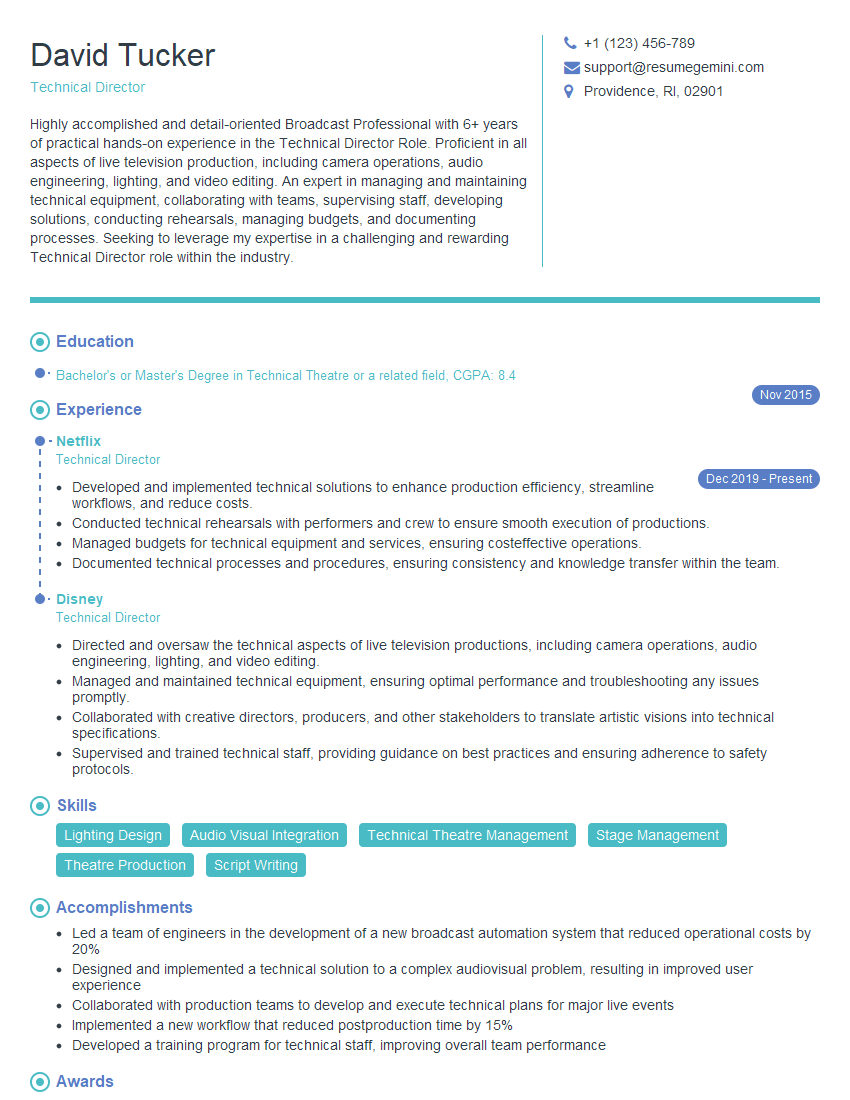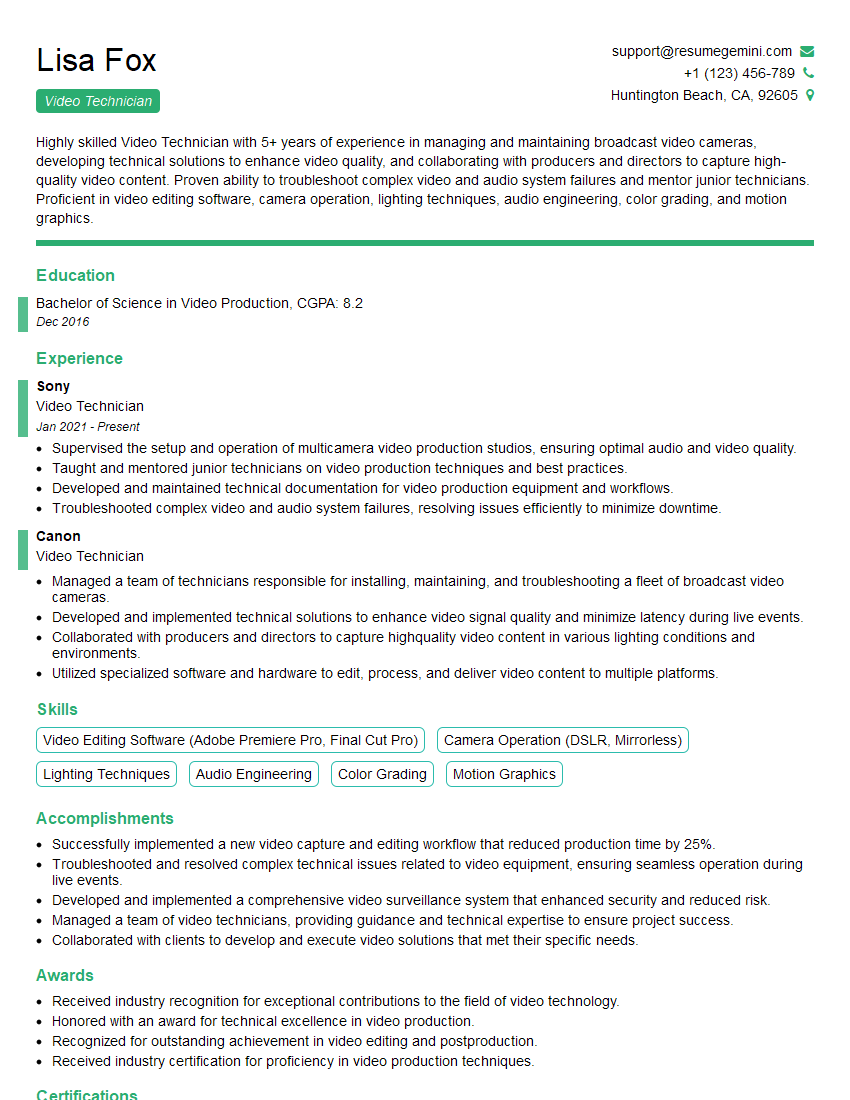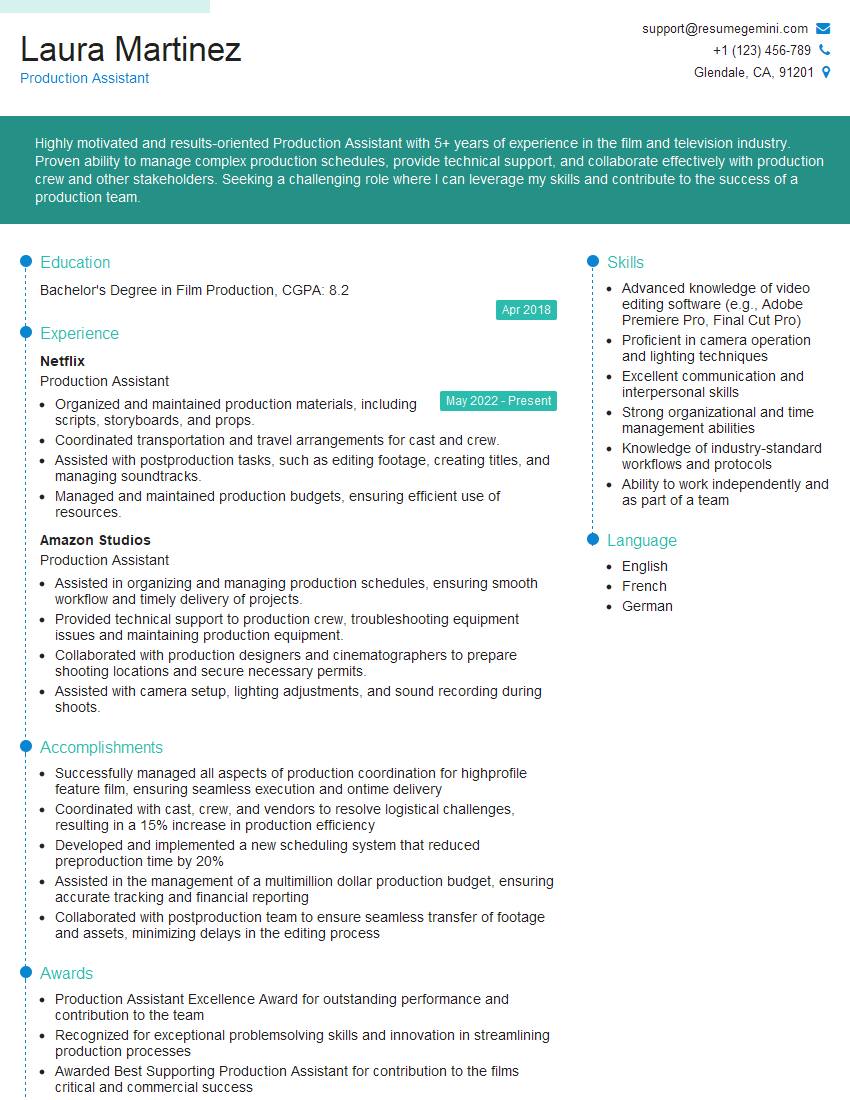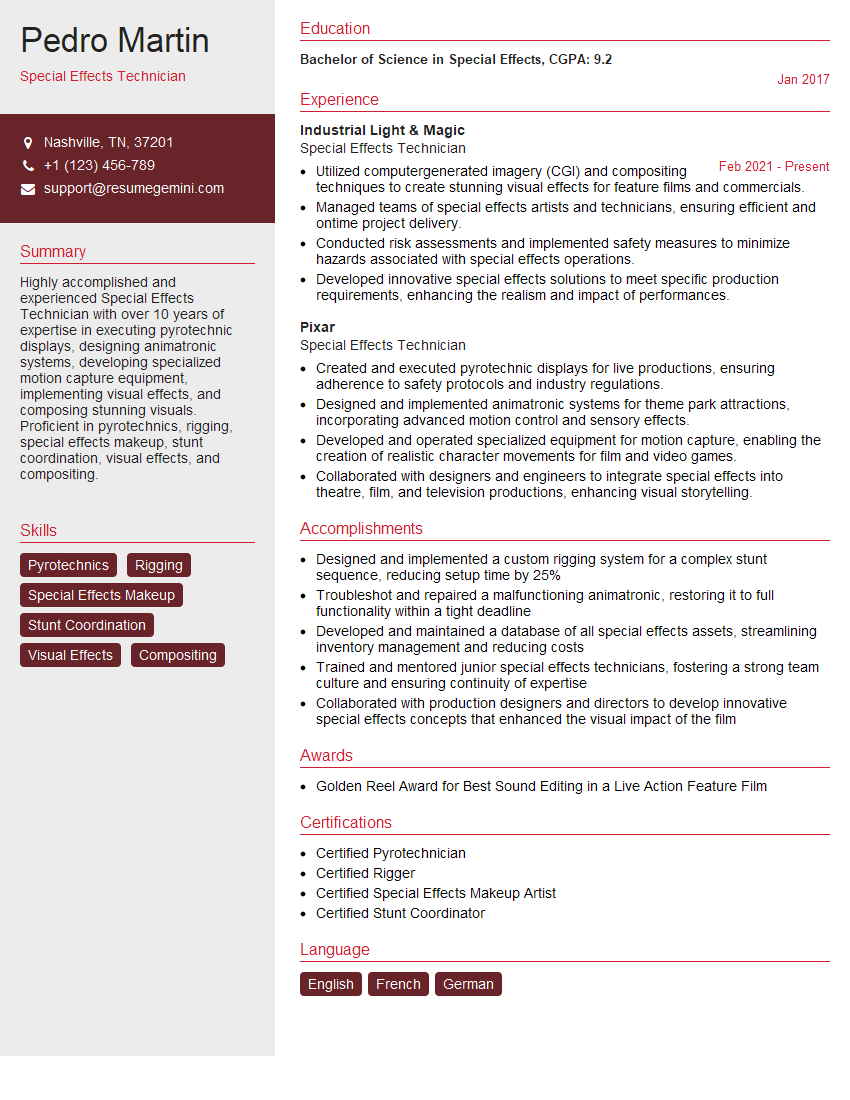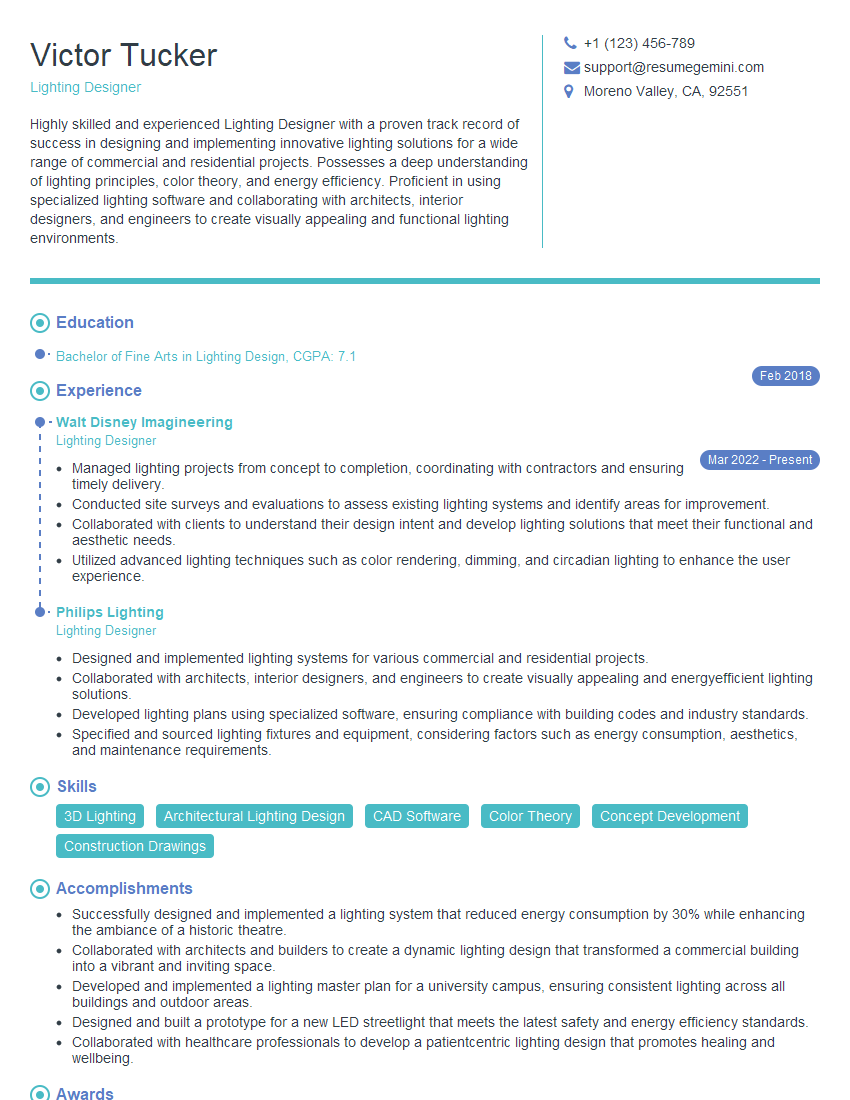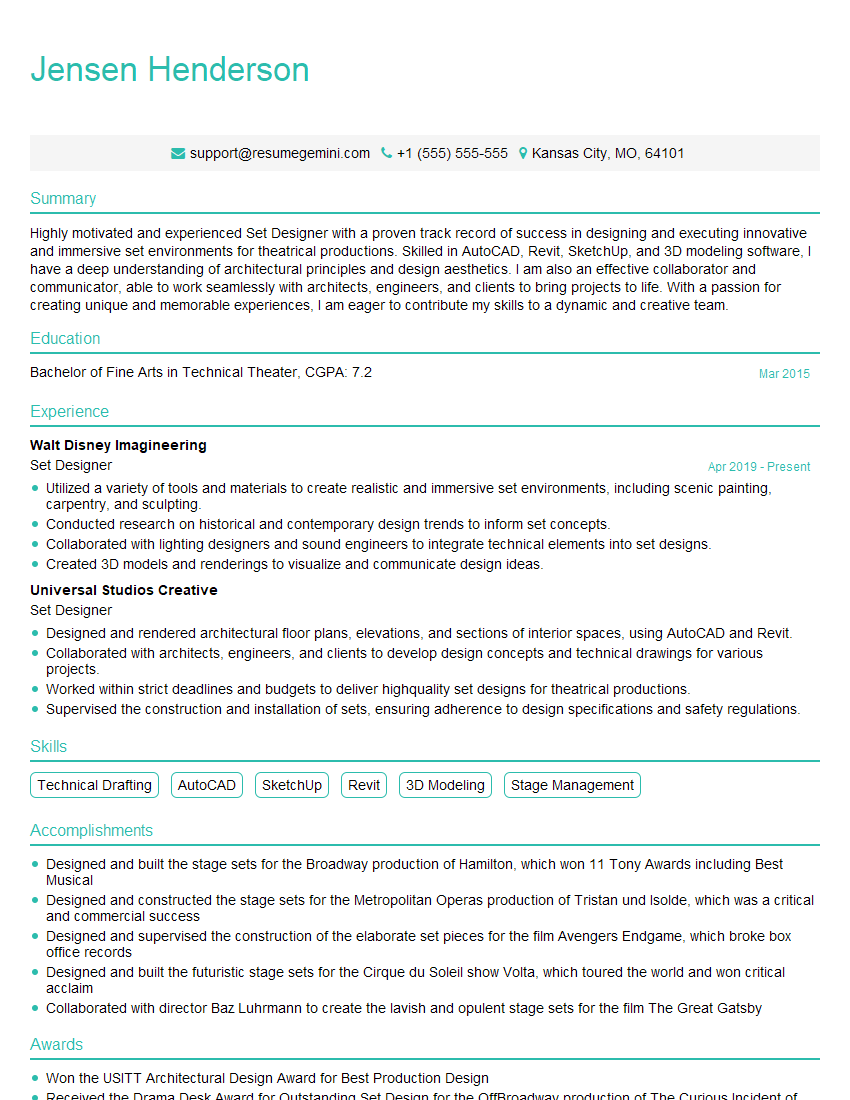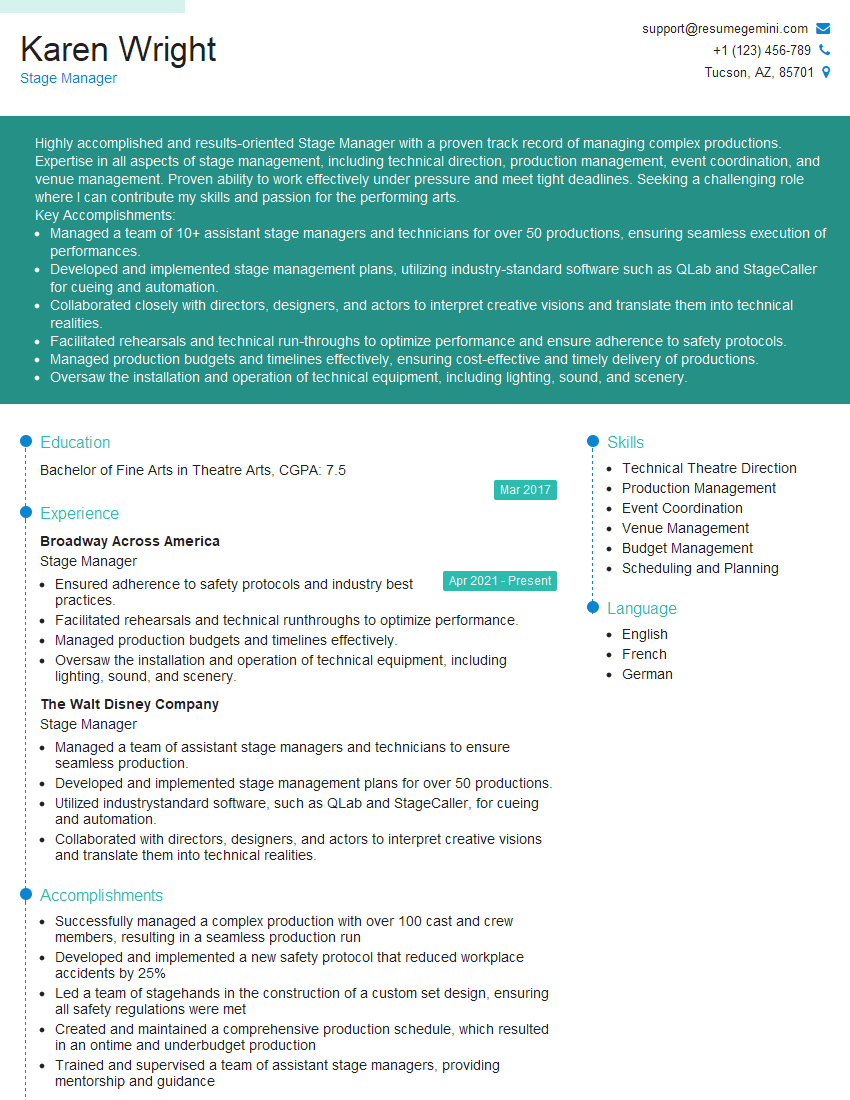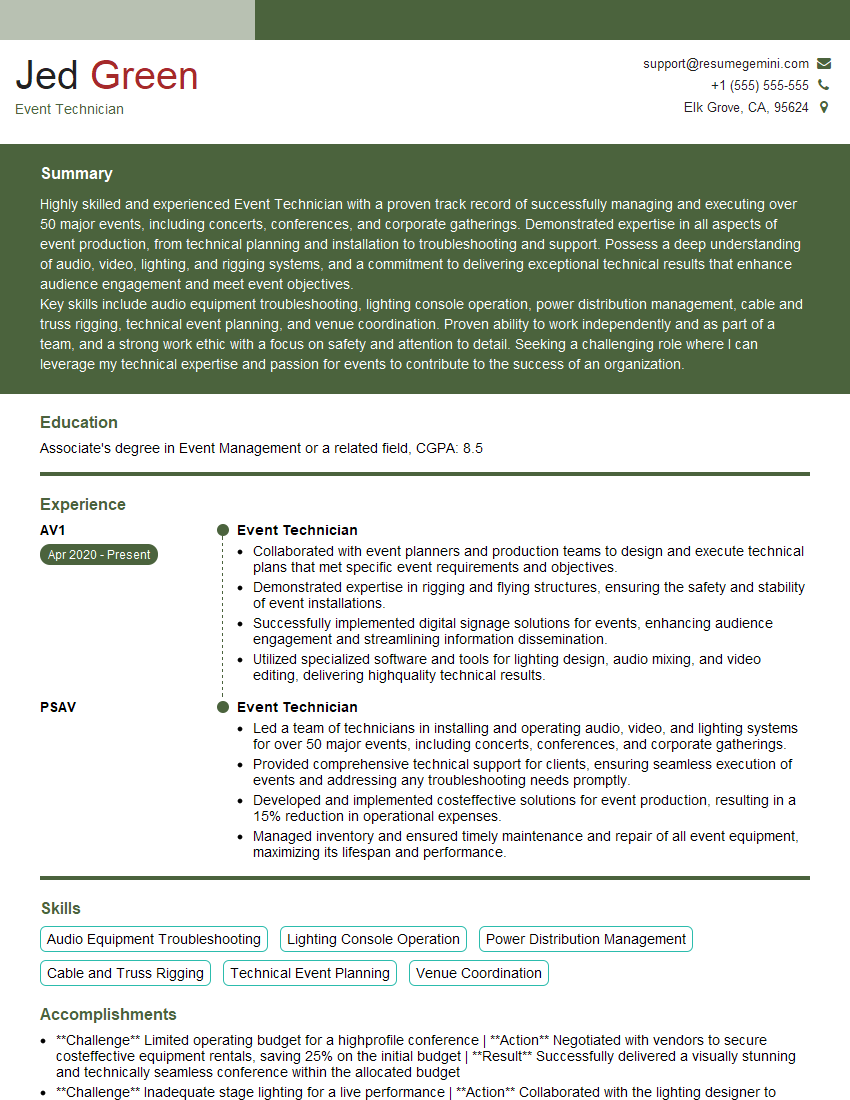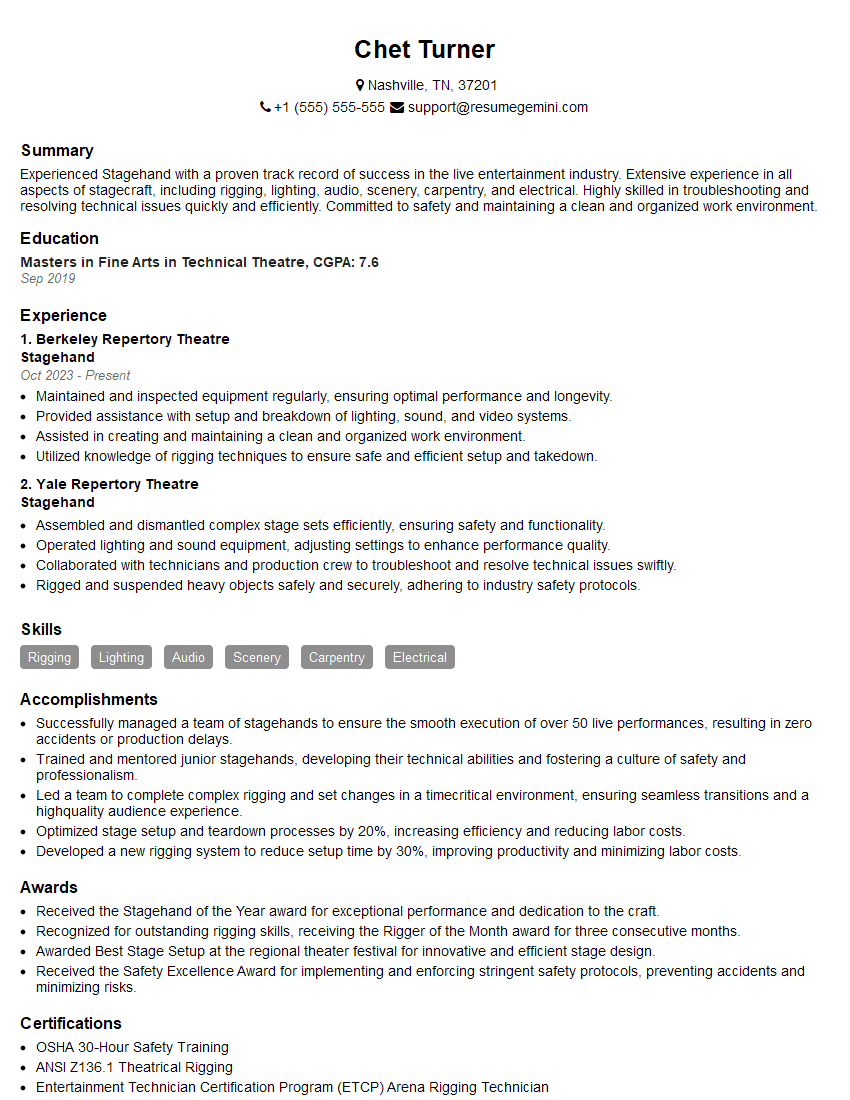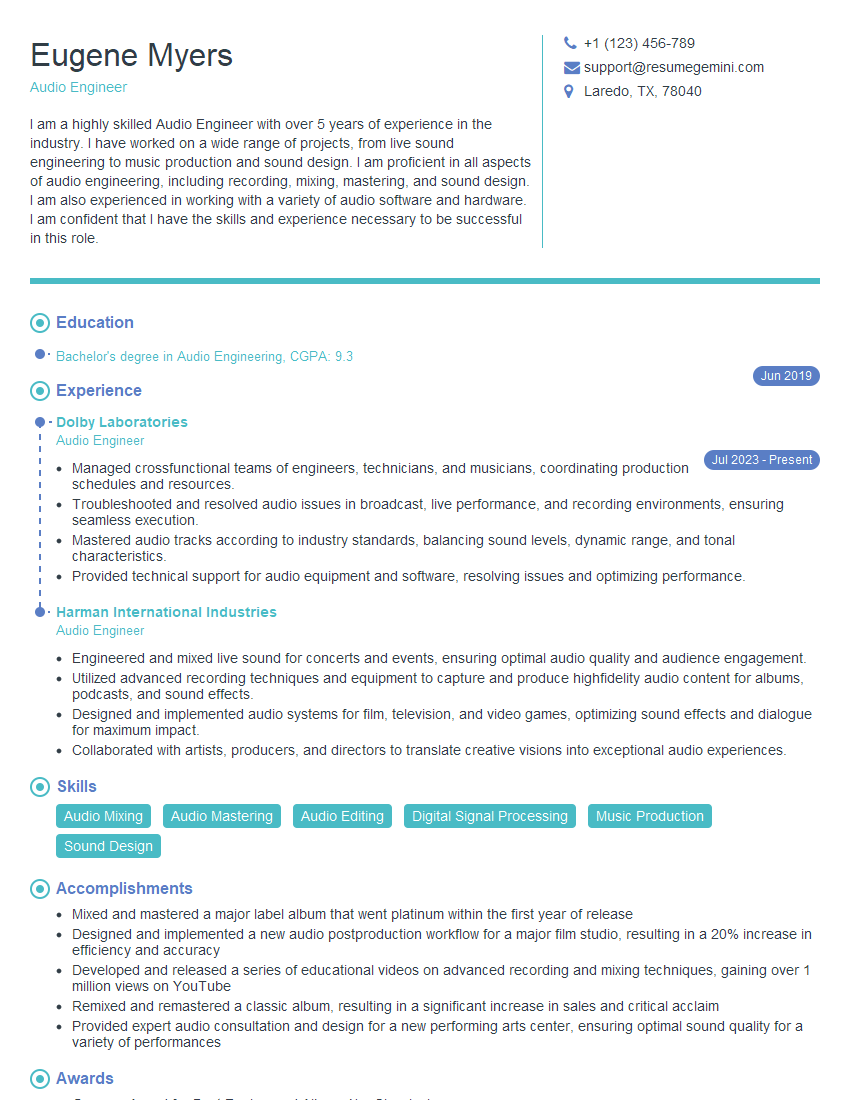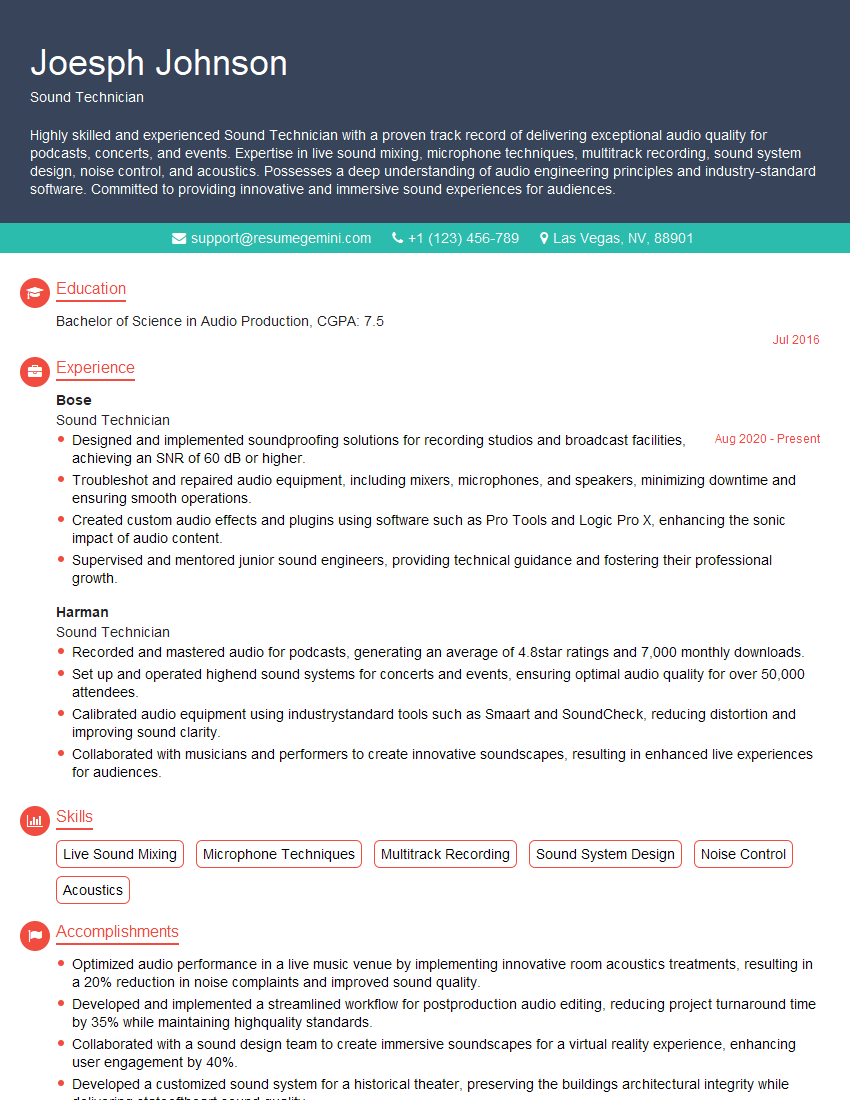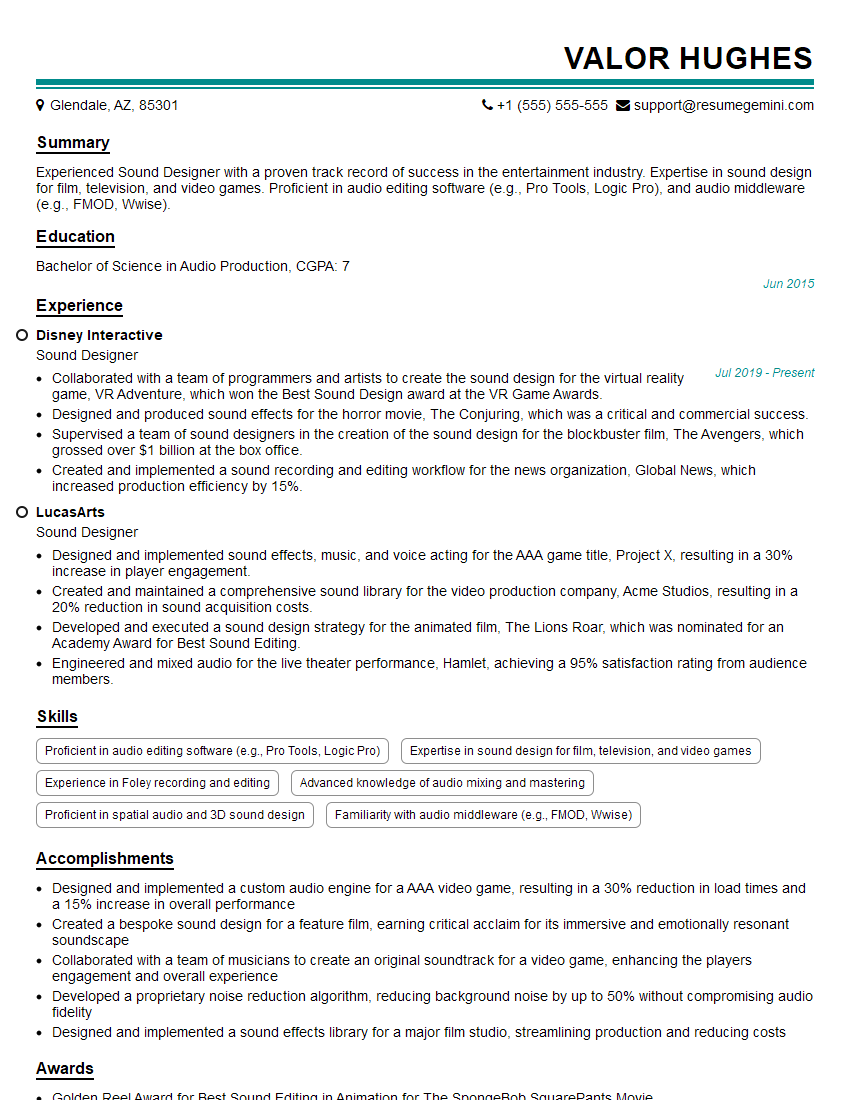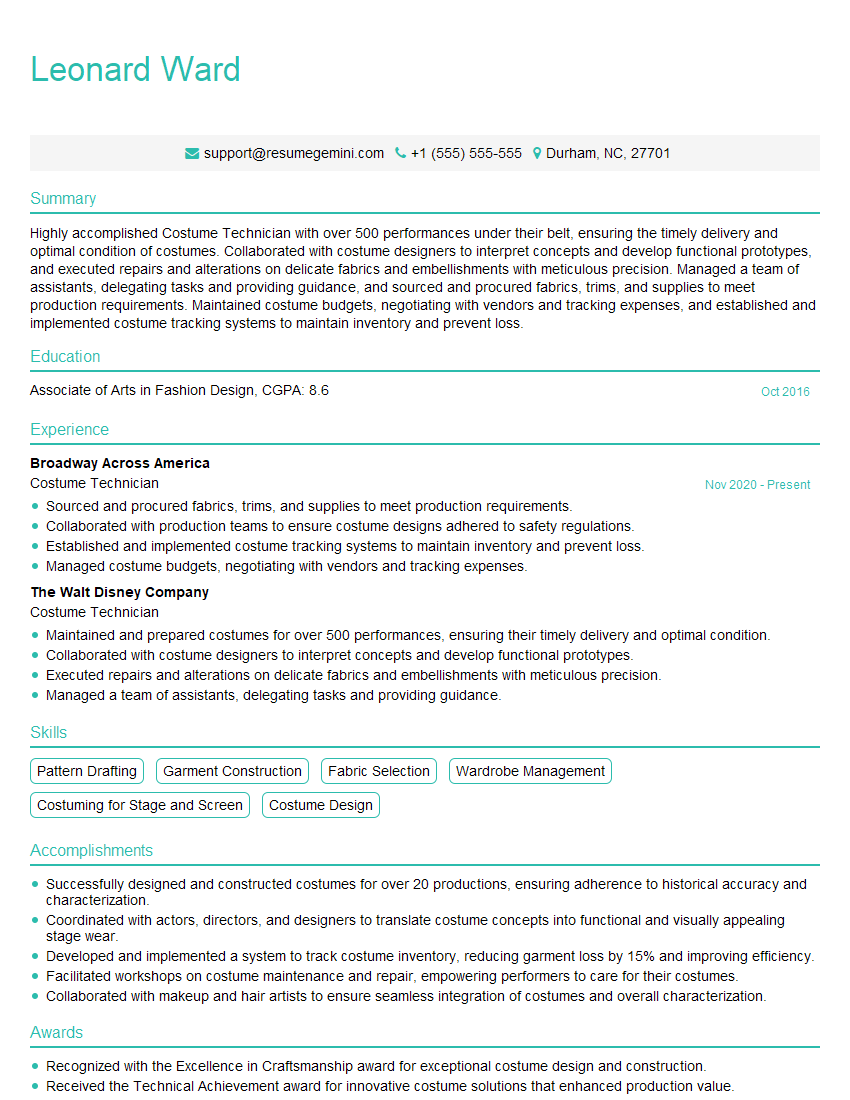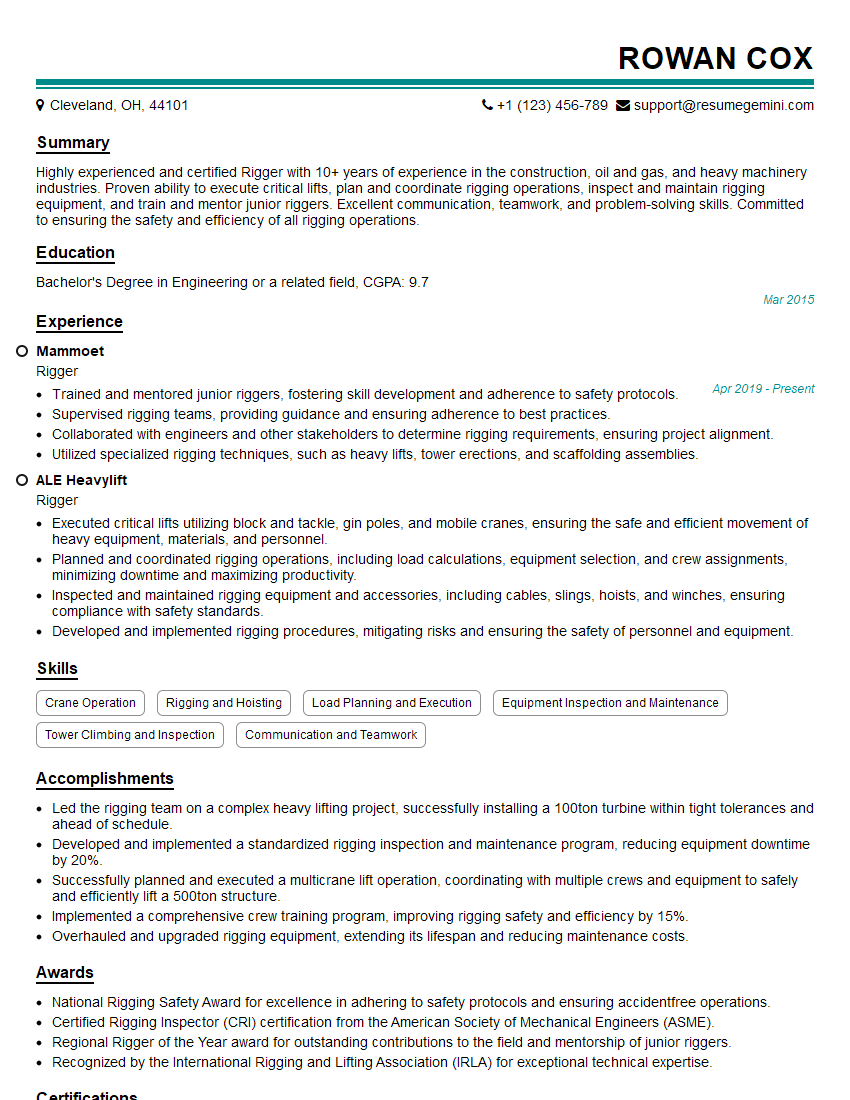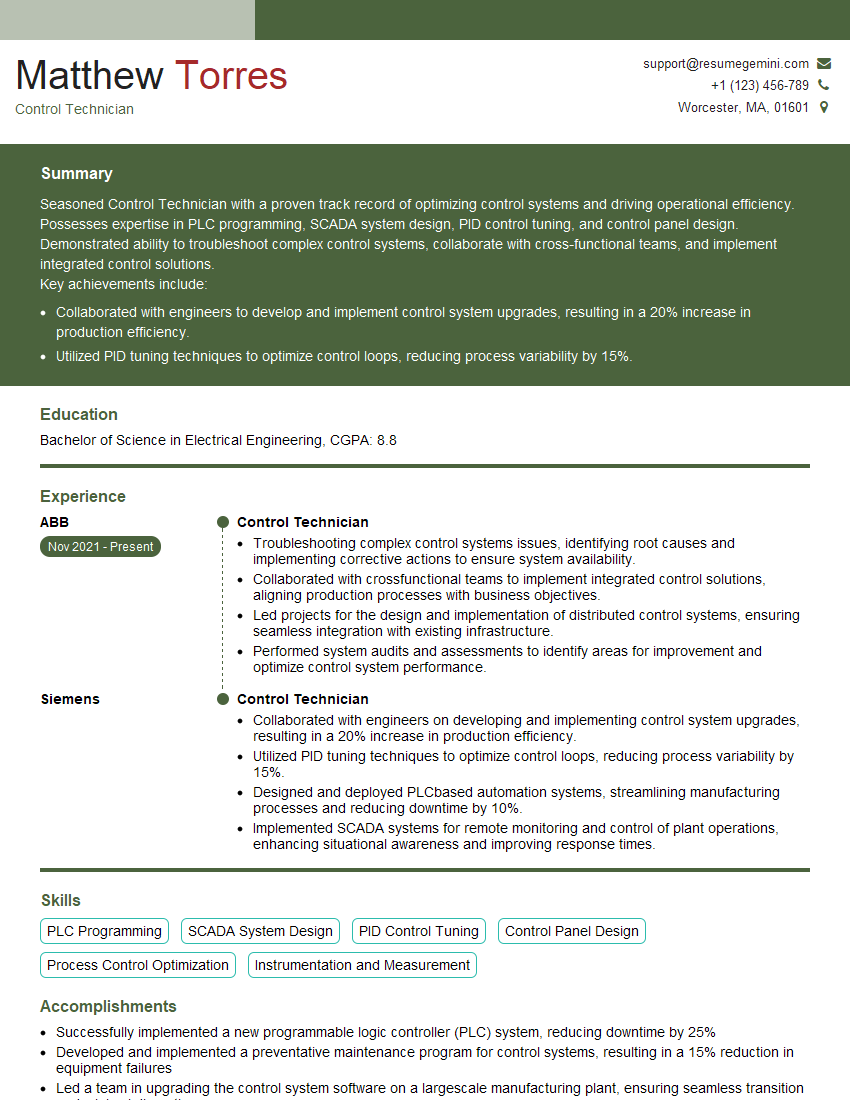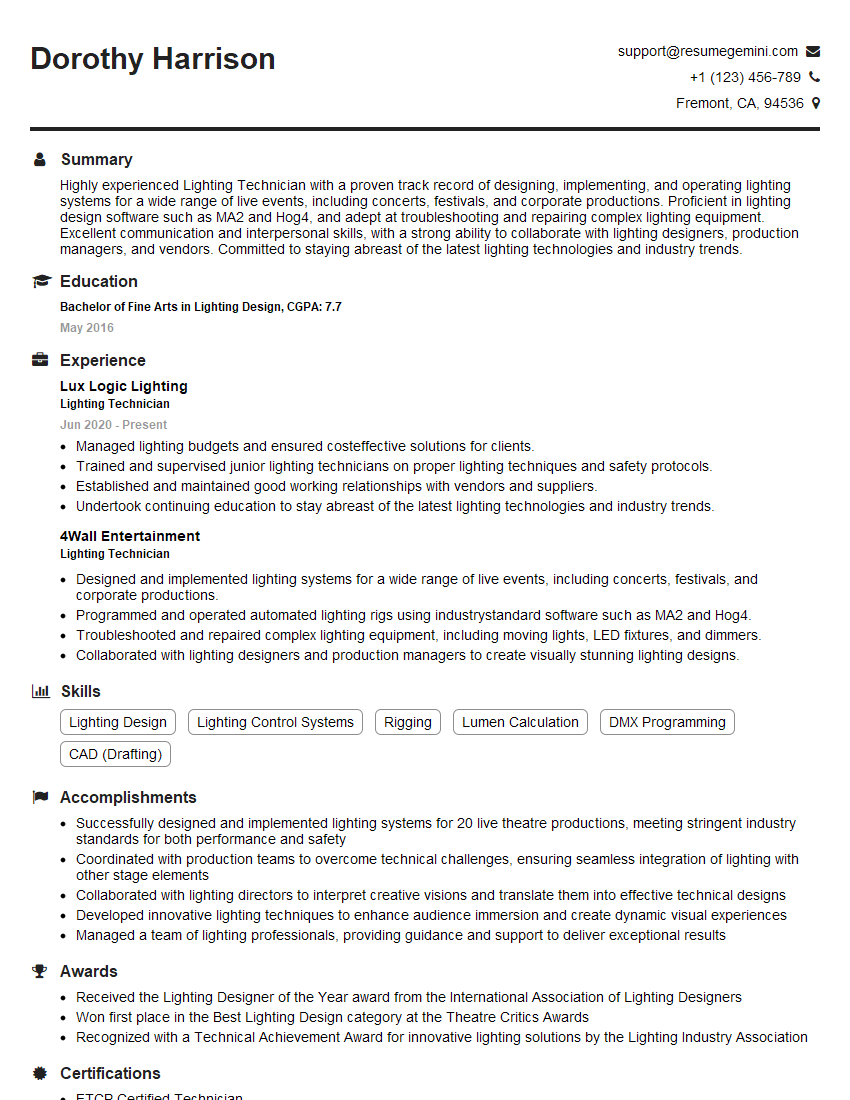The thought of an interview can be nerve-wracking, but the right preparation can make all the difference. Explore this comprehensive guide to Familiar with industry-standard stage equipment interview questions and gain the confidence you need to showcase your abilities and secure the role.
Questions Asked in Familiar with industry-standard stage equipment Interview
Q 1. Describe your experience with different types of stage lighting fixtures (e.g., LED, PAR, Fresnel).
My experience with stage lighting fixtures is extensive, encompassing a wide range of technologies and applications. I’m highly proficient with LED fixtures, appreciating their energy efficiency, long lifespan, and color-mixing capabilities. I’ve worked extensively with LED PAR cans, using them for both wash lighting and creating dynamic effects. Their versatility makes them ideal for a variety of settings, from intimate theatre productions to large-scale concerts. I also have significant experience with Fresnel lenses, which offer a very smooth, adjustable beam, perfect for highlighting specific areas of the stage or creating a soft, even wash. I understand how to manipulate beam spread and intensity to achieve specific lighting designs. Finally, I’ve worked with other types of fixtures including ellipsoidals (for sharp, focused beams), profile spots (for gobo projection), and moving lights (for dynamic effects), adapting my approach based on the specific needs of each production.
For example, in a recent theatre production, I used a combination of LED PAR cans for a vibrant background wash, Fresnel lights to highlight the actors’ faces, and ellipsoidals to create sharp, defined beams for specific stage elements. This careful selection and placement of fixtures ensured that the lighting perfectly complemented the narrative and mood of the play.
Q 2. Explain the difference between a dimmer pack and a lighting console.
A dimmer pack and a lighting console are both crucial components of a stage lighting system, but they serve very different purposes. A dimmer pack is simply a collection of dimmers, each controlling the intensity of a single lighting fixture. Think of it as a bunch of individual volume controls for your lights. Each dimmer receives a signal, typically 0-10V, and adjusts the power to the connected light accordingly. They provide the basic functionality to control light levels, but they lack the sophisticated control capabilities of a lighting console.
A lighting console, on the other hand, is the brains of the operation. It allows the operator to control multiple dimmer packs simultaneously, often hundreds of channels, creating complex and dynamic lighting cues. It provides features like cueing (saving and recalling lighting states), submasters (grouping channels for coordinated control), and sophisticated effects generation (like chases and fades). In essence, a dimmer pack is just the muscle, while the lighting console is the brain that directs the muscle’s actions. It’s like the difference between having individual switches for every light bulb in a house versus a sophisticated lighting system that can control everything from a single panel.
Q 3. How do you troubleshoot a faulty microphone?
Troubleshooting a faulty microphone involves a systematic approach, starting with the most basic checks and progressing to more complex solutions. The first step is always to verify the obvious: Is the microphone switched on? Is it properly connected to the mixer or interface? Is the cable secure at both ends? A simple visual inspection can often solve the problem. If the connection is good and the microphone is powered, we need to listen for feedback or static, this can pinpoint the cause. Does the problem persist if you switch microphones or use a different cable? This will isolate if the problem is the microphone itself, the cable, or the mixer input.
If the problem persists, I’d test the microphone on a different system to isolate whether the fault lies in the microphone, the cable, or the audio system. Next, I’d check the microphone’s battery (if applicable), ensuring it has sufficient charge. For wired microphones, check for any visible damage to the cable. If the problem persists, it might be necessary to replace the microphone entirely or contact the manufacturer for further assistance.
Q 4. What are your preferred methods for cable management on a stage?
Effective cable management is crucial for safety and efficient workflow on stage. My preferred methods involve a combination of strategies. First, I always use clearly labelled cables, colour-coded to identify different systems (audio, lighting, data). This makes troubleshooting much faster. Second, I utilize cable ties and Velcro straps to neatly bundle cables and prevent tangling. I also employ cable ramps and troughs to keep cables off the stage floor, reducing trip hazards and keeping everything neat. For long runs of cables, I use cable snakes to keep everything organized and protected. Finally, I use a combination of gaff tape and cable clips to secure cables to the floor or stage structures where appropriate. Proper cable management not only improves the look of the stage but is also essential for preventing accidents and ensuring a smooth performance.
Q 5. Describe your experience with rigging and safety protocols.
Rigging is a critical aspect of stage production that requires meticulous attention to detail and a strong understanding of safety protocols. My experience includes working with various rigging systems, from simple counterweight systems to motorized hoists and automated systems. I’m intimately familiar with the importance of regular inspections and the use of appropriate safety equipment, such as harnesses, lanyards, and fall arrest systems. Before any rigging operation, I always conduct a thorough risk assessment, identifying potential hazards and implementing appropriate mitigation measures. I also ensure that all personnel involved in rigging operations are properly trained and qualified. Safety is paramount – I never compromise on safety procedures, even under pressure.
For example, before any lift, I always conduct a thorough weight check and ensure the load is evenly distributed. I never exceed the weight capacity of any rigging component, and I always use appropriate safety factors. My commitment to safety extends to maintaining detailed rigging logs and conducting regular inspections to prevent equipment failure.
Q 6. What software are you proficient in for lighting or sound control?
My software proficiency includes a range of industry-standard lighting and sound control programs. I’m highly proficient in ETC Eos family (including Eos, Gio, and Ion), which is widely used in professional theatre and concert settings. I’m also familiar with MA Lighting grandMA2 and ChamSys MagicQ, offering a comprehensive range of control options. In the audio realm, I’m comfortable working with digital audio workstations (DAWs) such as Ableton Live and Logic Pro X for sound design and post-production. I also possess experience in using QLab, a powerful show control software that integrates seamlessly with lighting and sound systems.
Q 7. How familiar are you with various audio mixer configurations?
My familiarity with audio mixer configurations is extensive, encompassing both analog and digital mixing consoles. I understand various mixer topologies, including inline, split, and matrix configurations, and can adapt my approach depending on the size and complexity of the sound system. I’m comfortable working with mixers from leading manufacturers such as Yamaha, Soundcraft, and Allen & Heath. I understand the principles of gain staging, signal flow, equalization (EQ), compression, and other signal processing techniques. I can set up microphone inputs, balance levels, route signals to appropriate outputs, and utilize advanced mixing techniques such as aux sends and returns to achieve optimal sound quality and control. My understanding extends to digital audio networking protocols like Dante and AVB, crucial for managing large-scale sound systems.
For example, in a recent live concert setup, I used a Yamaha digital mixer to manage multiple microphone inputs, instrument channels, and playback tracks. I employed aux sends to create monitor mixes for the performers and utilized sophisticated EQ and compression to optimize the overall sound quality. The use of Dante networking ensured seamless signal transfer between the mixer and other audio devices.
Q 8. Explain your understanding of sound reinforcement principles.
Sound reinforcement is all about capturing, amplifying, and distributing sound effectively to an audience. It’s like building a bridge between the performer and the listener, ensuring the sound is clear, balanced, and powerful enough to be enjoyed by everyone. This involves several key principles:
- Gain Staging: Managing the signal levels at each stage of the process to prevent clipping (distortion) and maximize headroom (dynamic range). Think of it like controlling the flow of water in a pipe – too much pressure and the pipe bursts, too little and nothing gets through.
- Signal Flow: Understanding the path a signal takes from the microphone to the speaker, including mixing consoles, processors, and amplifiers. It’s crucial to understand the order of operations to avoid signal loss or unwanted effects.
- Equalization (EQ): Adjusting the balance of frequencies to compensate for room acoustics or to shape the sound of an instrument or vocal. This is like a sound sculptor, shaping the overall tone.
- Acoustic Treatment: Minimizing unwanted reflections and reverberations within a space. A poorly treated space will make the sound muddy and unclear. Imagine yelling in a bathroom versus a large empty field; the bathroom’s hard surfaces cause unwanted reflections.
- System Matching: Choosing and configuring components (microphones, speakers, amps, etc.) that are compatible and work efficiently together. This ensures optimal performance and reliability.
My experience covers a wide range of venues, from intimate clubs to large arenas, and I’ve consistently applied these principles to deliver high-quality sound in various acoustic environments.
Q 9. Describe your experience with different types of microphones and their applications.
I’m experienced with a wide variety of microphones, each tailored for specific applications. The choice depends heavily on the sound source and desired outcome.
- Dynamic Microphones (e.g., Shure SM58): Robust, feedback-resistant, ideal for live vocals, loud instruments (drums, guitar amps). These are workhorses that can handle high sound pressure levels. I’ve relied on these countless times for lead vocals on stage.
- Condenser Microphones (e.g., Neumann U87): More sensitive, capturing subtle nuances, excellent for recording studios or live applications where delicate sounds are important (e.g., acoustic instruments, orchestral work). These require phantom power and are more fragile than dynamic mics.
- Ribbon Microphones (e.g., Royer R-121): Known for their warm, smooth sound, often used for recording guitar amps or other instruments where a natural, less aggressive sound is desired. They are delicate and require careful handling.
- Boundary Microphones (e.g., Shure MX418): Designed to be mounted on a table or floor, commonly used in conferencing or recording situations requiring unobtrusive placement.
I’ve used these mics in various scenarios, selecting the most appropriate type based on the sonic requirements of the performance.
Q 10. What are your strategies for noise reduction during a live performance?
Noise reduction is critical for a clean and professional sound. My strategies include:
- Careful Microphone Placement: Positioning mics to minimize pickup of unwanted noise sources. This is often the most effective first step.
- Acoustic Treatment: Using absorptive materials (foam panels, bass traps) to reduce reverberation and control room acoustics. This minimizes noise reflections and enhances clarity.
- Gate/Expander: Using audio processors (gate or expander) to reduce background noise between musical passages. These act as noise filters.
- Notch Filters (EQ): To cut specific frequencies of unwanted noise (e.g., a persistent hum from a faulty power supply). This is a targeted approach to noise elimination.
- Feedback Suppression: Proper gain staging and microphone placement are key to avoiding feedback (a high-pitched squeal). This is especially important in live performances.
One memorable instance involved a show in a very reverberant space. By strategically placing absorption panels and using a combination of EQ and gating, we significantly reduced unwanted noise and achieved a pristine sound.
Q 11. Explain your process for setting up and aligning a sound system.
Setting up and aligning a sound system is a methodical process:
- System Design: Determining the necessary equipment based on the venue size, audience capacity, and type of performance.
- Cable Management: Running cables neatly and securely, labeling them for easy identification. This minimizes tripping hazards and simplifies troubleshooting.
- Speaker Placement: Strategically positioning speakers to provide even sound coverage throughout the venue, avoiding hotspots and dead zones. I often use speaker modeling software to predict sound distribution.
- Microphone Placement: Positioning microphones to optimize sound quality while minimizing feedback. I work closely with performers to find the optimal position.
- System Alignment: Using a sound level meter and test tones to ensure proper levels and frequency response. This includes equalization and delay settings.
- Sound Check: A thorough run-through with the performers to identify and address any issues before the performance. This is a crucial step for a smooth show.
This structured approach ensures a consistent and high-quality audio experience for the audience, regardless of the venue or equipment used.
Q 12. Describe your experience with different types of video projection systems.
My experience encompasses various video projection systems, each with its strengths and weaknesses:
- DLP Projectors: Known for their bright images and good contrast, suitable for brightly lit venues.
- LCD Projectors: Often offer better color accuracy and are suitable for various applications but can sometimes be less bright.
- LED Projectors: Energy-efficient, with a long lifespan and good color reproduction. Excellent for smaller venues or presentations.
- Front Projection: Projecting onto a screen from the front, the most common method, offering simplicity and wide screen sizes.
- Rear Projection: Projecting onto a screen from behind, ideal for transparent screens allowing for a pass-through for performers.
I’ve worked with different projector brands and models, adapting my approach depending on the requirements of each project. Choosing the right projector depends on factors like screen size, image quality, budget, and ambient light.
Q 13. How do you troubleshoot video playback issues?
Troubleshooting video playback issues requires a systematic approach:
- Check Connections: Ensure all cables are securely connected and there’s no damage. This is always the first step.
- Check Source: Verify that the video file is playing correctly on the source device (computer, media player). Sometimes the problem isn’t the projector.
- Check Resolution: Ensure the video resolution matches the projector’s native resolution. Incompatible resolutions can cause issues.
- Check Brightness/Contrast: Adjust these settings for optimal viewing. Sometimes the problem is simply poor settings.
- Check Input Source: Verify the correct input source is selected on the projector. It’s easy to overlook this simple detail.
- Check Lamp/Bulb: If the image is dim or there are issues with color, the lamp might be failing. This is less common with LED projectors.
I’ve successfully resolved various video playback problems using this process, ensuring a smooth and uninterrupted presentation.
Q 14. What are your experience with various types of stage rigging hardware?
I have extensive experience with various stage rigging hardware, including:
- Trusses: Aluminum or steel structures used to support lighting, sound, and other equipment. Understanding truss types, load capacities, and safe assembly is paramount.
- Chain Hoists: Motorized lifting devices used to raise and lower heavy equipment efficiently and safely. Regular maintenance is crucial for safety.
- Winches: Manual or electric devices for lifting and tensioning. These often support drapes or other lighter items.
- Counterweights: Used in counterweight systems to balance the weight of lighting and other equipment. Precise balancing is essential for safety.
- Connectors and Fittings: The correct hardware is essential for safe rigging. Using the wrong connector can be dangerous.
Rigging safety is my top priority. I always follow all relevant safety regulations and guidelines. My experience includes working with both simple and complex rigging systems, and always using proper safety procedures and spotters.
Q 15. How familiar are you with weight limits and safety regulations for rigging?
Rigging safety is paramount. My familiarity with weight limits and regulations is extensive, encompassing both theoretical knowledge and hands-on experience. I understand that exceeding weight limits can lead to catastrophic failures, resulting in serious injury or death. Therefore, I always begin with a thorough load calculation, taking into account the weight of the equipment, the rigging hardware (e.g., shackles, cables, chains), and any additional factors like wind load. I meticulously check the Working Load Limit (WLL) of each component, ensuring that the total load is well within the safe operating range. This involves consulting manufacturer specifications and utilizing appropriate safety factors. I’m also proficient in different rigging techniques, such as using multiple lifting points for even weight distribution, and always double-check all connections before any lift occurs. For instance, during a recent production, we were rigging a large video screen. My team and I performed a detailed load calculation, accounting for the screen’s weight, the rigging system’s components, and even the potential sway from wind. We meticulously documented every step of the process, and our meticulous attention to detail ensured a smooth and safe operation.
Furthermore, I’m intimately familiar with relevant safety regulations and standards, such as OSHA guidelines (in the US) or equivalent regulations in other jurisdictions. This includes understanding the importance of regular inspections, proper training for personnel, and emergency procedures in case of equipment malfunction.
Career Expert Tips:
- Ace those interviews! Prepare effectively by reviewing the Top 50 Most Common Interview Questions on ResumeGemini.
- Navigate your job search with confidence! Explore a wide range of Career Tips on ResumeGemini. Learn about common challenges and recommendations to overcome them.
- Craft the perfect resume! Master the Art of Resume Writing with ResumeGemini’s guide. Showcase your unique qualifications and achievements effectively.
- Don’t miss out on holiday savings! Build your dream resume with ResumeGemini’s ATS optimized templates.
Q 16. What is your experience with setting up and operating playback systems for media?
I have extensive experience with various playback systems, from simple media servers to complex control systems managing multiple video and audio sources. I’m proficient in operating systems such as QLab, Resolume Arena, and vMix. My experience ranges from setting up straightforward presentations to intricate, multi-layered shows involving synchronized video, audio, and lighting cues. I’m comfortable working with a range of media formats, ensuring compatibility and seamless playback. For example, on a recent musical theater production, I managed a system with three media servers, synchronizing video projections with live performances. This required precise timing and coordination, and I utilized QLab’s scripting capabilities to create a highly reliable and responsive playback system. I also understand the importance of redundancy and backup systems in live performance environments, mitigating the risk of technical failures.
Beyond operation, I’m also adept at troubleshooting common issues like media format incompatibility, synchronization problems, and hardware malfunctions. My problem-solving skills are honed to handle any unexpected challenges during a show.
Q 17. Describe your experience with different types of stage effects (e.g., smoke, haze).
My experience with stage effects spans a wide range of technologies and approaches. I’m familiar with various types of smoke and haze machines, understanding their differences in output density, dissipation rates, and the effects they produce. For instance, low-lying fog machines create a more dramatic, atmospheric effect, while haze machines create a subtle, ethereal ambiance. I also consider environmental factors when choosing effects. A large, well-ventilated space might allow for heavier fog effects than a smaller, less ventilated one. Safety is a key concern; I’m aware of the potential hazards associated with fog and haze, such as reduced visibility and the importance of proper ventilation, and I always ensure compliance with relevant safety guidelines.
Beyond smoke and haze, I’ve worked with other stage effects such as moving lights, lasers, and pyrotechnics (under the supervision of licensed pyrotechnicians, of course). Each requires its own specific safety protocols and operational knowledge. I understand how to integrate these effects to create compelling visual experiences while ensuring the safety of performers and audience members.
Q 18. How do you ensure the safe operation of stage machinery?
Safe operation of stage machinery is non-negotiable. My approach involves a multi-layered system of checks and balances. Firstly, I always ensure that all machinery is properly inspected and maintained before each show, following manufacturer recommendations and relevant safety regulations. This includes checking for any signs of wear, damage, or malfunction. Secondly, I emphasize thorough training for all personnel operating the machinery. This training covers proper operation procedures, emergency protocols, and the importance of following all safety guidelines. Regular practice and drills are key to ensuring a smooth and safe operation. Thirdly, I employ a system of locking and tagging out procedures to prevent accidental operation during setup, maintenance, or repairs. Finally, I meticulously document all inspections and maintenance activities, ensuring a clear audit trail for accountability and safety compliance. In the event of any malfunction or emergency, I have established procedures to quickly and safely respond, prioritizing the safety of performers and crew.
Q 19. What is your experience with troubleshooting electrical issues on stage?
Troubleshooting electrical issues on stage requires a methodical and safety-conscious approach. I possess a strong understanding of basic electrical principles, including voltage, amperage, and grounding. I always start by isolating the problem area to prevent further damage or risk of electric shock. This typically involves visually inspecting the wiring and connectors for any obvious issues, such as loose connections, damaged cables, or blown fuses. I’m familiar with using multimeters to diagnose electrical problems, accurately measuring voltage, current, and resistance. I’m adept at identifying common electrical problems such as short circuits, ground faults, and blown circuits. For example, I once encountered an issue where a lighting fixture stopped working. By methodically checking the circuit breakers, the wiring to the fixture, and the fixture itself, I quickly identified a blown fuse and replaced it, restoring power to the fixture. I always prioritize safety – working with electricity requires caution, and I always follow established safety procedures to mitigate risk.
Q 20. Explain your process for creating a stage plot.
Creating a stage plot is a fundamental part of my work. My process begins with a thorough understanding of the show’s requirements, including the set design, lighting, sound, and special effects. I’ll often work closely with the director, set designer, and technical director to develop a comprehensive plot that meets everyone’s needs. I use industry-standard software such as Vectorworks or AutoCAD to create detailed drawings, showing the placement of all stage elements, including set pieces, lighting fixtures, microphones, and other equipment. These drawings include precise measurements and indicate the type and quantity of each element. The plot also includes information about power requirements, cable routing, and any necessary access points for stage crew. During the process, I carefully consider factors such as sightlines, access for performers and crew, and potential safety hazards. For instance, I ensure there are sufficient walkways and clear areas to prevent accidents. The final stage plot is a crucial document used throughout the production, guiding the setup and operation of the show, ensuring a smooth and efficient process.
Q 21. Describe your experience with working with different types of stage scenery.
I have experience working with a diverse range of stage scenery, from simple flats and drapes to complex, multi-level sets. I understand the construction techniques and materials used in creating scenery, including wood, metal, fabric, and composites. My experience extends to both building and assembling scenery, ensuring proper construction techniques for stability and safety. I’m also familiar with various rigging techniques used to hang and secure scenery, always prioritizing safety and ensuring proper weight distribution. For example, I’ve worked on productions using traditional flats, modern scenic constructions, and even immersive, interactive sets. This experience has equipped me to manage any scenic challenges, from simple setups to complex, multi-layered designs. I also understand the importance of proper maintenance and storage of scenery to preserve its condition and longevity.
Q 22. How familiar are you with the operation and maintenance of a follow spot?
Operating and maintaining a follow spot requires a blend of technical skill and artistic sensitivity. It’s more than just pointing a light; it’s about creating a dynamic visual experience for the audience.
My experience encompasses various follow spot models, from older manual units to the latest computerized systems. I’m proficient in lamp changes (including understanding the different lamp types and their wattage implications), iris and shutter control, color filter manipulation, and precise beam focusing. Regular maintenance, for me, includes cleaning the lens, checking the lamp’s hours, and ensuring all moving parts are lubricated and functioning smoothly. I also know how to troubleshoot common issues like flickering bulbs or malfunctioning controls, often diagnosing the problem through systematic checks and using my knowledge of electrical systems and optics.
For example, during a recent musical production, a sudden power surge caused the follow spot’s lamp to fail mid-performance. Instead of panicking, I quickly switched to a backup lamp, having already ensured it was ready beforehand. This prevented any significant interruption to the show, minimizing disruption.
Q 23. What are your experiences with different types of stage curtains and drapery?
My experience with stage curtains and drapery is extensive, covering a wide range of fabrics, weights, and functionalities. I’m familiar with various types, including:
- Velvet: Offers excellent light absorption and creates a rich, dramatic look.
- Muslin: A versatile, lightweight option often used for backdrops and scrims.
- Fire Retardant Fabrics: Essential for safety compliance, these fabrics meet specific fire safety standards and are crucial for any professional setting.
- Cyc Cloths: Large, seamless backdrops, typically white or neutral, perfect for projections.
I understand the importance of proper hanging, weighting, and maintenance of these elements. I’m adept at rigging curtains, using various methods such as counterweights, electric hoists, and manual lines. I’m also experienced in dealing with common problems like rips, tears, and color fading, implementing appropriate repair techniques. This includes understanding the significance of proper cleaning methods to ensure the longevity of the materials.
One specific instance involved repairing a large cyclorama that had sustained a tear. Using specialized repair techniques and materials, I was able to seamlessly patch it, ensuring its use in the production without compromising the visual effect.
Q 24. How do you manage time effectively during a fast-paced production?
Time management in fast-paced productions relies heavily on meticulous planning and prioritization. I use a combination of techniques to stay organized and efficient. This includes:
- Detailed Scheduling: Creating and adhering to a meticulously planned schedule with clearly defined tasks and deadlines.
- Prioritization: Focusing on the most critical tasks first, ensuring that time-sensitive operations are completed on time.
- Teamwork: Effectively delegating tasks and working collaboratively with other crew members to ensure a smooth workflow.
- Flexibility: Adapting to unexpected situations and prioritizing tasks accordingly, understanding that unforeseen circumstances might arise.
For example, during a recent show with tight turnaround times between scenes, I coordinated with the lighting and sound crews to ensure a seamless transition. By pre-planning all necessary changes and assigning responsibilities clearly, we avoided delays and maintained the fast-paced energy of the production.
Q 25. Describe your experience with problem-solving in a high-pressure environment.
Problem-solving in high-pressure environments requires a calm, methodical approach and a well-honed ability to think on your feet. My experience involves using a structured approach:
- Identify the problem: Accurately assess the situation and gather relevant information.
- Analyze potential solutions: Explore multiple potential solutions, weighing their pros and cons.
- Implement the chosen solution: Quickly and efficiently execute the most effective solution, while also considering safety precautions.
- Evaluate the results: Assess the outcome to ensure the problem is solved and to learn from the experience.
During a live performance, a crucial lighting fixture malfunctioned. Instead of panicking, I immediately switched to a backup fixture, and then quickly diagnosed the problem as a loose connection while another crew member adjusted the lighting cues. Communicating with the lighting designer and crew about the solution provided a quick recovery and minimal disruption to the flow of the production.
Q 26. How do you communicate effectively with other members of the technical crew?
Effective communication is the backbone of any successful theatrical production. I prioritize clear, concise, and respectful communication with all crew members. My approach involves:
- Clear and concise language: Using precise terminology to avoid misunderstandings.
- Active listening: Paying attention to what others are saying and asking clarifying questions.
- Non-verbal communication: Using hand signals or other non-verbal cues when appropriate, especially in noisy environments.
- Regular check-ins: Maintaining open communication channels throughout the production process.
For instance, during a complex stage setup, I used a combination of verbal instructions and hand signals to coordinate the placement of heavy equipment with other crew members ensuring safety and efficiency. This method proved highly effective in a busy environment where verbal communication could have been easily missed.
Q 27. Explain your understanding of health and safety regulations relevant to stage work.
Health and safety are paramount in stage work. My understanding encompasses several key areas:
- Risk Assessment: Identifying and assessing potential hazards like falling objects, electrical hazards, and fire risks.
- Safe Working Practices: Adhering to strict safety protocols, including the correct use of safety equipment like harnesses, gloves, and eye protection.
- Emergency Procedures: Knowing emergency procedures and the location of fire exits, first-aid kits, and emergency contact numbers.
- Regulations Compliance: Staying up-to-date with relevant health and safety regulations, including those related to lifting, rigging, and electrical work.
I’m certified in [Mention any relevant safety certifications, e.g., OSHA 10 or similar] and always prioritize safety above all else. This includes conducting regular safety checks on equipment, making sure emergency exits are clear, and ensuring all crew members understand and adhere to the safety guidelines. A recent example involved noticing a frayed electrical cable; I immediately reported it to the appropriate personnel, preventing a potential electrical hazard.
Key Topics to Learn for Familiar with Industry-Standard Stage Equipment Interview
- Lighting Equipment: Understanding different types of lighting instruments (e.g., Fresnels, PAR cans, LED fixtures), their functionalities, and setup procedures. Practical application: Troubleshooting lighting issues during a show, setting up a basic lighting plot.
- Sound Equipment: Familiarity with microphones (dynamic, condenser, lavalier), mixers, amplifiers, speakers, and their connection and operation. Practical application: Setting up a sound system for a small performance, troubleshooting audio feedback.
- Rigging and Safety: Knowledge of safe rigging practices, weight limits, and the use of appropriate equipment (e.g., chains, ropes, pulleys). Practical application: Understanding and adhering to safety regulations when hanging lighting or sound equipment.
- Stage Management Tools & Procedures: Understanding call sheets, run-of-show documents, and communication protocols within a stage crew. Practical application: Efficiently managing a backstage environment and assisting with smooth transitions between acts.
- Audio-Visual (AV) Technologies: Basic knowledge of video projection systems, screen setup, and troubleshooting common AV problems. Practical application: Supporting a presentation or video playback during a performance or event.
- Troubleshooting and Problem-Solving: Developing systematic approaches to identify and resolve technical issues quickly and effectively. Practical application: Quickly diagnosing and fixing problems with lighting, sound, or other stage equipment during a performance.
Next Steps
Mastering industry-standard stage equipment is crucial for career advancement in live events, theatre, and entertainment. A strong understanding of these technologies demonstrates valuable technical skills and problem-solving abilities, making you a highly sought-after candidate. To maximize your job prospects, it’s vital to create an ATS-friendly resume that highlights your expertise. ResumeGemini is a trusted resource for building professional, impactful resumes. Use ResumeGemini to craft a compelling resume showcasing your proficiency in handling stage equipment. Examples of resumes tailored to this field are available within the ResumeGemini platform. Take the next step in your career journey today!
Explore more articles
Users Rating of Our Blogs
Share Your Experience
We value your feedback! Please rate our content and share your thoughts (optional).
What Readers Say About Our Blog
Interesting Article, I liked the depth of knowledge you’ve shared.
Helpful, thanks for sharing.
Hi, I represent a social media marketing agency and liked your blog
Hi, I represent an SEO company that specialises in getting you AI citations and higher rankings on Google. I’d like to offer you a 100% free SEO audit for your website. Would you be interested?

